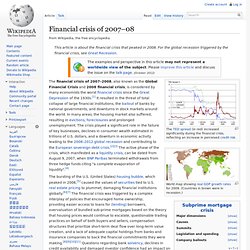

Credit Crunch Explained. 2007-2011 United States housing bubble. The United States housing bubble is an economic bubble affecting many parts of the United States housing market in over half of American states.

Housing prices peaked in early 2006, started to decline in 2006 and 2007, and reached new lows in 2012.[2] On December 30, 2008 the Case-Shiller home price index reported its largest price drop in its history.[3] The credit crisis resulting from the bursting of the housing bubble is — according to general consensus — the primary cause of the 2007–2009 recession in the United States.[4] Increased foreclosure rates in 2006–2007 among U.S. homeowners led to a crisis in August 2008 for the subprime, Alt-A, collateralized debt obligation (CDO), mortgage, credit, hedge fund, and foreign bank markets.[5] In October 2007, the U.S. Secretary of the Treasury called the bursting housing bubble "the most significant risk to our economy.
"[6] Any collapse of the U.S. Financial Crisis Inquiry Report. Greenspan Retracts. JIM LEHRER: Judy Woodruff has our financial crisis story tonight.

JUDY WOODRUFF: The former chair of the Federal Reserve and one of the best-known names in finance returned to Capitol Hill today for the first time since the financial crisis began. Alan Greenspan, who headed the Fed for 18 years, until early 2006, appeared with the chairman of the Securities and Exchange Commission, Chris Cox, and former Treasury Secretary John Snow, at a hearing examining the role of federal regulators in the current crisis. ALAN GREENSPAN, Former Federal Reserve Chairman: We are in the midst of a once-in-a-century credit tsunami. Central banks and governments are being required to take unprecedented measures. JUDY WOODRUFF: Greenspan has been criticized for decisions he made earlier this decade that some economists charge helped to foster the housing bubble. REP. ALAN GREENSPAN: Partially. REP. You had the authority to prevent irresponsible lending practices that led to the subprime mortgage crisis.
REP. Global Financial Crisis. The TED spread (in red) increased significantly during the financial crisis, reflecting an increase in perceived credit risk.

US Housing Bubble. Bush's Bubble. As bad as Bush's economic record is, it would appear far worse if not for the housing bubble. The latest data on growth suggest that the economy may again be faltering, just when President Bush desperately needs good numbers to make the case for his re-election. Fannie Mae Meltdown. Shadow Banking System. The shadow banking system is a term for the collection of non-bank financial intermediaries that provide services similar to traditional commercial banks. Former Federal Reserve Chair Ben Bernanke provided a definition in April 2012: "Shadow banking, as usually defined, comprises a diverse set of institutions and markets that, collectively, carry out traditional banking functions--but do so outside, or in ways only loosely linked to, the traditional system of regulated depository institutions. Examples of important components of the shadow banking system include securitization vehicles, asset-backed commercial paper (ABCP) conduits, money market mutual funds, markets for repurchase agreements (repos), investment banks, and mortgage companies.
" Shadow banking has grown in importance to rival traditional depository banking and was a primary factor in the subprime mortgage crisis of 2007-2008 and global recession that followed.[1] [2] Overview[edit] Collateralized debt obligation. CDO - Interactive Features. Mortgage-backed security. A mortgage-backed security (MBS) is a type of asset-backed security that is secured by a mortgage, or more commonly a collection ("pool") of sometimes hundreds of mortgages.

The mortgages are sold to a group of individuals (a government agency or investment bank) that "securitizes", or packages, the loans together into a security that can be sold to investors. The mortgages of an MBS may be residential or commercial, depending on whether it is an Agency MBS or a Non-Agency MBS; in the United States they may be issued by structures set up by government-sponsored enterprises like Fannie Mae or Freddie Mac, or they can be "private-label", issued by structures set up by investment banks.
MBS Explained. Hedge Funds. Derivatives. Many money managers use derivatives for a variety of purposes, such as hedging — by taking a position in a derivative, losses on portfolio holdings may be minimized or offset by profits on the derivative.

Likewise, derivatives can be used to gain quicker and more efficient access to markets; for example, it may be easier and quicker to purchase an S & P 500 futures contract than to invest in the underlying securities.[3] Derivatives are a contract between two parties that specify conditions (especially the dates, resulting values and definitions of the underlying variables, the parties' contractual obligations, and the notional amount) under which payments are to be made between the parties.[4][5] The most common underlying assets include commodities, stocks, bonds, interest rates and currencies, but they can also be other derivatives, which adds another layer of complexity to proper valuation.
Still, even these scaled down figures represent huge amounts of money. Rating Agencies Ignore UnSafe Loans.